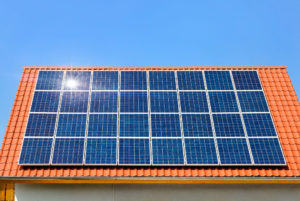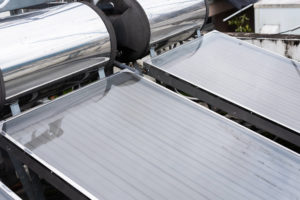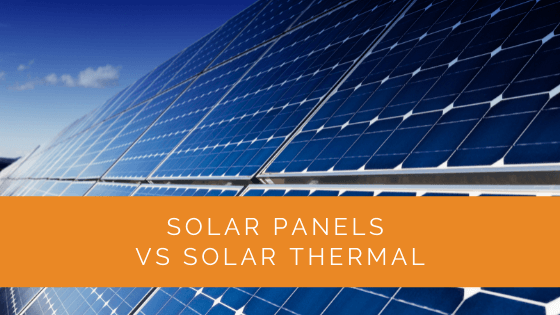With the rising demand for a cleaner and environment-friendly lifestyle, renewable energy sources are becoming more important daily. As a result, solar energy is gaining a lot of popularity.
Both solar photovoltaic or solar PV systems and solar thermal panels can convert the sun rays into electricity and heat you can use. The principle behind both types of solar panels is the same. However, there are differences.
Despite being two completely different types of renewable energy, they are both derived from the sun. Therefore, they are both similar in some ways and are extremely reliable. The two types of solar panels use different technologies to produce energy, so it is wise to understand the differences.
Contents
- 1 Key Takeaways:
- 2 What Are Solar PV?
- 3 What Is the Difference Between Solar Energy And Solar Thermal Energy?
- 4 What Are Solar PV Panels?
- 5 The Advantages of PV Solar Panels
- 6 The Disadvantages of Solar PV Panels
- 7 What Is a Solar Thermal System?
- 8 The Advantages of Solar Thermal Panels
- 9 The Disadvantages of Solar Thermal Panels
- 10 Case Study: Integrating Solar PV and Solar Thermal Systems
- 11 Expert Insights From Our Solar Panel Installers About Solar Panels vs Solar Thermal
- 12 Discover the Power of Solar with Solar Panels Network
- 13 The Final Verdict: Which One Is Better?
Key Takeaways:
- Solar panels (PV) and solar thermal systems both harness solar energy but serve different purposes: PV panels generate electricity, while solar thermal technology creates heat.
- Solar PV panels offer advantages like reducing energy bills, longevity, and versatility. In contrast, solar thermal panels are more efficient at collecting sunlight for heating water and have a shorter payback period.
- The choice between the two depends on specific needs and factors like climate, available space, and budget, with solar PV panels offering more potential for technological development in the future.
What Are Solar PV?
Solar power will be mentioned when you discuss clean, cheap, and most resourceful energy sources in the world. The solar energy obtained from the sun via heat and light is converted into electrical and thermal power.
In an ideal situation, solar energy conversion occurs via photovoltaic panels or mirrors that concentrate the solar radiation.
What Is the Difference Between Solar Energy And Solar Thermal Energy?
When the solar rays fall upon the earth’s surface, it creates direct solar power. Now, there are two methods of utilising this solar energy.
- Solar panels (PV)
- Solar thermal systems
Apart from the ability to utilise solar energy, there is not much similarity between the two. They may even seem to have similar appearances, but their functions are as different as it gets. In simple terms, solar panels generate electricity, whilst solar thermal technology creates heat. To understand their differences, let’s talk about them briefly.
What Are Solar PV Panels?
One of the systems commonly found on top of solar farms is Solar PV. The technology obtains energy from the sun using photovoltaic cells (PV). The best part about these cells is that they do not require direct sunlight.
Therefore, these panels can generate substantial power even under low light conditions. That means you do not have to worry about cloudy or winter days. The PV cells can convert the sunlight into electricity after obtaining it.
This energy is used to run various household appliances and lighting. They help bring your energy bills down and reduce your carbon footprint. There is no noise either while generating the power.
There are three types of solar panels out there:
- Monocrystalline panels
- Polycrystalline panels
- Thin-film solar cells
The monocrystalline panels are the most efficient and expensive, while the thin-film solar cells are the least efficient and cheapest.

The Advantages of PV Solar Panels
Savings
Now, despite the initial high capital cost, solar PV panels can save you the consumption of fossil fuels. This can bring your energy cost down by 70%. Moreover, solar energy itself is a free and renewable energy source. The most interesting part is that installing solar PV panels increases the resale value of your home.
Maintenance
There is no need for too much maintenance as the solar panels can sustain for a very long time. If you compare solar thermal panels, the longevity of the solar PV panels is higher. On average, you can expect a solar PV system to last up to four decades.
Energy Dependence
Once you install solar PV panels, you will become much less dependent on the National Grid for power supply. That means you will no longer be affected by local power outages or operational errors. This system is useful in producing excess electricity.
Versatility
Solar Photovoltaic technology generates cleaner and greener electricity and has various other applications. You can even heat water and charge your RV using these panels.
The Disadvantages of Solar PV Panels
Higher Capital Cost
The initial cost of installing a solar system is pretty high. Despite the financial return on investment, this cannot be ignored.
Suitability
Although most properties are suitable for installing solar PV, some factors must be considered. Location and availability of ample sunlight are essential for energy production.
Long-term investment
The return on a solar PV panel investment may take around seven to 20 years. The highly expensive installation, therefore, will take some time to compensate. So, it is only suitable for people with permanent residences.
What Is a Solar Thermal System?
The solar thermal power system is also known as a solar collector. Solar Thermal Panels follow the solar thermal heating method when capturing solar energy. Energy obtained in this method can be used to heat water. It is a hugely beneficial way of fulfilling the hot water need at home.
There is not much installation cost involved either. It costs about the same as installing PV solar systems. The best part is that you can enjoy hot water all year round with this system installed, as the system is fully automated.
Like the solar PV panels, the solar thermal system is also mounted on the roof space. This is done to give them the highest level of sun exposure. Once the sun heats the device, the tube liquid warms up. Usually, glycol is used with antifreeze.
This liquid is then transported into the water tank. The installation and functionality are simple and yet highly efficient. Moreover, solar thermal panels are fully compatible with your existing water-heating systems, like boilers and immersion heaters.

The Advantages of Solar Thermal Panels
Solar Savings
Solar thermal panels save you a lot of money on your energy costs. You can enjoy a free, clean and renewable energy source that will cover all your heating
requirements.
Efficient
These panels are more efficient than PV panels because heatwaves can carry more energy than sunlight. These panels are 70% more efficient in collecting sunlight than a solar PV system.
Shorter Payback
The installation is cheaper and provides a shorter payback than solar PV panels.
The Disadvantages of Solar Thermal Panels
Initial cost
Whenever you install any solar system, the initial cost will be high. However, you can expect a return on that within a year.
Limited storage
The solar energy collected by PV panels can be stored in batteries. However, this is more difficult for thermal panels since storing hot water longer without any heat loss is tricky. So, you need to be more mindful when using the water.
Inconsistency
Despite its higher efficiency, it is not as effective during winter days. Since the heat from the sun is not sufficient during this time, it makes the device less versatile than PV panels.
Shorter lifespan
When you rely solely on green energy to warm your water, it becomes inconsistent due to various climate conditions.
Case Study: Integrating Solar PV and Solar Thermal Systems
Background
In response to increasing energy costs and a desire to reduce their environmental impact, a homeowner in the South of England sought to install renewable energy systems. They wanted to utilise both solar photovoltaic (PV) and solar thermal technologies to meet their household’s electricity and hot water needs. Our team at Solar Panels Network was tasked with designing and implementing a solution that would maximise energy efficiency and cost savings.
Project Overview
The project’s primary goal was to install a dual-system setup combining solar PV panels and a solar thermal system. The PV system was intended to generate electricity for household use, while the solar thermal system would provide hot water. The challenge was to integrate these systems seamlessly and ensure they functioned efficiently, even during the less sunny winter months.
Implementation
- Scaffolding Setup: We erected scaffolding around the property to ensure safety and ease of access during the installation process.
- Mounting and Installation: Both solar PV panels and solar thermal collectors were installed on the roof, carefully positioned to maximise sunlight exposure throughout the day.
- System Integration: The solar thermal system was connected to the existing water heating infrastructure, while the PV panels were linked to the household electrical grid to facilitate energy distribution.
- Monitoring and Testing: A monitoring system was installed to track real-time energy production and consumption, allowing for efficient management and optimisation of the system’s performance.
Results
- Electricity Generation: The solar PV panels produced sufficient electricity to cover the household’s daily needs, with surplus energy being stored in a battery system for use during non-peak sunlight hours.
- Energy Independence: The system reduced the homeowner’s reliance on the National Grid, providing a reliable backup during power outages and ensuring consistent energy availability.
- Cost Savings: The solar thermal system significantly reduced gas usage by efficiently heating water, resulting in lower utility bills and substantial cost savings over time.
- System Performance: Even during the winter months, the evacuated tube collectors maintained a steady supply of hot water, demonstrating the system’s reliability and efficiency in variable weather conditions.
Summary
The successful installation of combined solar PV and solar thermal systems provided the homeowner with a comprehensive renewable energy solution. The dual approach maximised energy generation and cost savings, ensuring year-round efficiency and reliability. This project highlights the benefits of integrating different solar technologies to achieve energy independence and long-term financial benefits.
Expert Insights From Our Solar Panel Installers About Solar Panels vs Solar Thermal
Solar PV panels are ideal for homeowners looking to reduce their electricity bills and enjoy long-term savings. They provide clean energy and have a longer lifespan, making them a valuable investment.
Senior Solar Installer
While solar thermal systems are highly efficient for heating water, they have limitations in colder climates. For consistent energy production, especially in the UK, solar PV panels coupled with heat pumps can be a more reliable choice.
Renewable Energy Consultant
Choosing between solar PV and solar thermal depends on your specific needs. If you’re looking for versatility and the potential to power various household appliances, solar PV is the way to go. However, for direct water heating needs, solar thermal is highly efficient.
Lead Solar Technician
Discover the Power of Solar with Solar Panels Network
Are you navigating the world of solar installations? Look no further than Solar Panels Network, the UK’s trusted partner in harnessing the sun’s potential. Our dedication goes beyond just installations; we’re on a mission to transform how homeowners and businesses across the UK perceive and utilise energy. By choosing us, you’re reducing your carbon footprint and making a smart financial move that promises savings for years ahead. Contact us today and embark on your solar journey.
The Final Verdict: Which One Is Better?
Solar thermal and solar PV panels are good examples of clean, green energy. Solar technology and solar thermal technology have few similarities and many differences. However, choosing between the two can be difficult.
Since solar PV technology is relatively new compared to solar thermal panels, it also has much to offer in the future. Solar thermal may be less space-consuming, more efficient, and cheaper than PV panels.
Despite these, solar PV panels have a better technological development scope. Moreover, it is the perfect solution to fulfil all your needs while providing excess electricity. In a cold UK climate, solar thermal systems may not be able to produce the amount of heat needed.
Therefore, you can use a solar-powered heat pump instead to fulfil your hot water needs. Coupling the PV panels with an immersion diverter resembles a solar thermal panel. Plus, this is a more cost-effective and low-maintenance solution.
About the Author
Solar Panels Network stands at the forefront of solar energy solutions, driven by a team of seasoned solar engineers and energy consultants. With over decades of experience in delivering high-quality solar installations and maintenance, we are committed to promoting sustainable energy through customer-centric, tailored solutions. Our articles reflect this commitment, crafted collaboratively by experts to provide accurate, up-to-date insights into solar technology, ensuring our readers are well-informed and empowered in their solar energy decisions.

